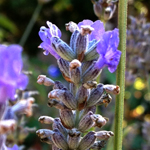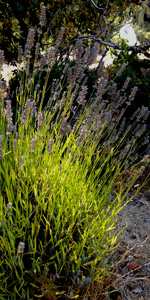Lavender
Lavendula officinalis, L. angustifolia, L. vera
family:Lamiaceae
 The Plant: Lavender is a low spiky blue-green shrub with clusters of bright purple flowers atop rigid straight spikes. The leaves are small, narrow & blade shaped, with some species edges lobed. The blue-violet flowers are in whorls on spikes and are highly aromatic, fading in color as they dry to a greyish purple 'lavender' color. A wild native from the Mediterranean, it loves sun and dry soil and can be found now in gardens around the world.
The Plant: Lavender is a low spiky blue-green shrub with clusters of bright purple flowers atop rigid straight spikes. The leaves are small, narrow & blade shaped, with some species edges lobed. The blue-violet flowers are in whorls on spikes and are highly aromatic, fading in color as they dry to a greyish purple 'lavender' color. A wild native from the Mediterranean, it loves sun and dry soil and can be found now in gardens around the world.
Parts used: flowers
Preparation: tea, tincture, essential oil, topically in salves, bath soaks & aromatically in bundles
 Medicinal actions: relaxing nervine, antispasmodic, carminative, antidepressant.
Medicinal actions: relaxing nervine, antispasmodic, carminative, antidepressant.
Indication: Lavender is a powerful relaxing herb with much of its medicine carried in its aromatic oils. Lavender is useful for anxiety and fatigue. It can help bring on sleep, relax digestive tension in the belly (carminative), relax the mind and body from stress-induced tension (antispasmodic), and ease menstrual cramps. Lavender is known as a mood-lifting herb that an help with depression. Simpy inhaling the scent can be calming & soothing on the nerves & psyche. It has been used for centuries in baths, food and in dried aromatic bundles.
Lavender has an anti-inflammatory, antiseptic quality when applied topically, as a tincture, tea or essential oil, and is especially useful as an essential oil topically on burns or infection, being gentle enough to use a drop or two for children or during pregnancy.
Contraindications: none known.
note: This information is not a replacement for a trained herbalist. Please consult your medical professional before treating yourself or others with this or any other herbal remedy.